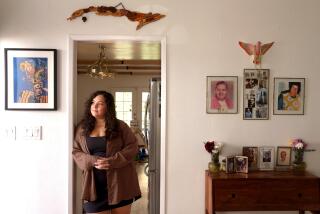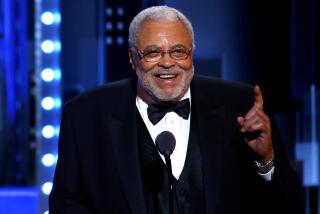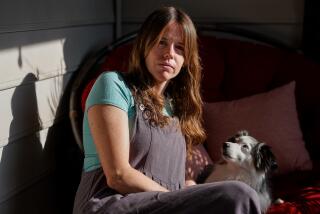METHODS IN THE MADNESS OF ACTING
Strasberg, Meisner, Adler, Hagen: the names of the New York acting-teacher elite. But Los Angeles has its teaching luminaries as well: Jeff Corey, Nina Foch, Salome Jens, Robert Lewis, among others.
There’s a creative energy here, along with a sensibility, style and discipline. Call it “The L.A. Method.”
At the root of everyone’s method, it seems, is the continuing influence of one man: Russian-born actor/teacher Konstantin Sergeivich Stanislavsky (1865-1938).
“Now, Stanislavsky didn’t invent anything,” said actor/coach Guy Stockwell. “But he studied actors--and when he saw one doing something especially powerful and effective, he’d ask, ‘How’d you do that?’ And the actor would explain the best he could.
“Then Stanislavsky would go to another actor. And he found that they were all doing the same thing: using different words, a lot of craft, superstition sometimes--but essentially the same thing.
“In effect, what Stanislavsky was doing was modeling excellent behavior. And once he had a clear enough model, shaking all the nonsense out of it, he taught other people the same model--and lo and behold, they became excellent actors.”
Yet beyond Stanislavsky (the desire to create--and encapsulize--a creative, correct performance), a survey of the more high-profile Los Angeles acting schools found huge variations in teaching approaches, price range (from $20 per class up to $200 per hour for private consultation--and more than $3,600 for an academic-year’s tuition) and opinions--including the usefulness of classical training for the contemporary actor.
“Training in the classics is still important,” maintains Bryn Morgan, director of Pasadena’s American Academy of Dramatic Arts. “Even though there isn’t much exposure to that kind of material in this town, there is a tremendous amount of classical work being done today in regional theater. So it will always be part of the training we give our actors.”
Estelle Harman, who introduces classics at her intermediate level, feels “the goal is not to develop Shakespearian masters, but his work is a great exercise for voice. And after they’ve studied Shakespeare, the students always find the contemporaries so easy.”
Jeff Corey encourages classical fare, with numerous play anthologies and source books in his recommended reading list. And Nina Foch, who admitted to “sneaking in a little education,” offers “two reasons to make people do Shakespeare: so it’s not scary, and so they see how they can use it. Because the principles--for whatever material--are really all the same.”
The goals may be similar, but what’s also obvious is that acting teachers bring their own personalities to whatever techniques they embrace--and that personality sets the tone for the entire class. Accordingly, some instructors are more friendly with students, some more scholarly oriented, some take a colleague-type attitude, some are very much the authority figure, some are punctual, some are quite tardy.
And in the larger institutions--with several teachers on the payroll--it can be a melding of many personal styles.
At the American Academy of Dramatic Arts (originally founded in New York in 1884), a staff of 16 presides over a two-year program including work in voice and speech, singing, musical theater, movement, dance and study of literature, from the Greeks to Shakespeare to modern.
“Of course, everyone works differently,” said alumnus/staffer Scott Ramp. “But that’s the nice thing here: Each teacher has a method that works for him. And we request that in class each student tries that person’s method, so that at the end of their two years here (an A.A. is possible upon graduation), they will have had a sampling of different styles--and then they can choose their own.”
In other cases, the party line is more pronounced. At the Estelle Harman Actor’s Workshop (where a certificate of achievement is available after three years’ study), Harman acknowledged: “I certainly don’t want my teachers to be second-rate Estelles--although, of course, most of them have studied with me. So everyone here has the same basic philosophy.”
Ditto Tracy Roberts (who has taught the majority of people working for her) and the Lee Strasberg Institute, where the founder’s widow, Anna, insists that all instructors “have been taught by Lee firsthand.”
And what exactly are they all teaching?
Actress/coach Salome Jens (currently performing her one-woman “ . . . About Anne” at Stages) is one of the champions of Strasberg. Having also studied with Herbert Berghof, Alvina Krause, Uta Hagen and Stella Adler, Jens proclaimed: “Lee was the only one who gave me any craft.”
Subsequently, her twice-weekly classes in Silver Lake--alternating scene study (including the classics “when they’re ready”) and sensory/technical work--rely heavily on the Strasberg tradition, mixed in with Jens’ own interpretations and adjustments.
“The process is about going through barriers,” she said, “finding the truth and re-creating. Always re-creating.”
Much of that ability, she believes, comes with age: “I don’t think you can start from nowhere. Lee said that people shouldn’t study before (age) 21, that they hadn’t had enough life experience--and I agree. Young people should be studying history and literature and looking at what’s around them in the world. Because an actor has to know it all, be a reflection of his time.”
Actor/coach Jeff Corey (who presides over twice-weekly classes from his Malibu home and a studio in North Hollywood) has different feelings about the Method.
“All of this talk of ‘real feelings’ leads to emotional hernia,” he said. “I think actors just want to act .” Corey’s own personal credo, to “esteem individuality,” is reflected in the focus of his teaching. “At the core is you: surrounded by imagination, assumptions, character traits--but you, you’re at the core.
“When you enjoy an actor in something, most often you’re reacting to the emanation of the individual playing the part. So there’s no Jeff Corey stamp on people who’ve studied with me. They are themselves. Of course, there’s no doubt that some influence creeps in. But it’s certainly not imitative.
“To this day, I’ll teach something and feel, ‘This is kind of like Roman Bohnen’ (a leading actor of the Group Theatre, of which Corey was also a member)--or do a scene and say, ‘There’s a bit of Walter (Huston, an early idol) in this. So it happens. But I stress to the students that they should love the kind of human beings they are.”
For actor/coach Robert Lewis, the bottom line is simple: Work. Since 1950, his Robert Lewis Theatre Workshop (originally based in New York, locally since 1983) has functioned on Lewis’ belief that “The better the artist, the more he has to keep in training.
“The only people who don’t are actors. Our actors. ‘Oh, what wonderful actors!,’ everyone said of the European companies during the Olympic Arts Festival. Well, they’re no better than our actors. But they do work on it, every day.
“My thing is to make good actors, capable of playing world repertory,” he stated. Accordingly, Lewis offers twice-weekly master classes on “material from the world” (Shakespeare, avant-garde, Restoration), another in contemporary/realistic scene work and a technique class--the latter utilizing “all kinds of exercises, improvisations. I know a lot of other people teaching somebody else’s thing. Not me.”
Nor Guy Stockwell. His 25 years of teaching (including basic acting, “trancework” and “personal power” seminars) have led him to NLP (Neuro-Linguistic-Programming), a system developed by associate Peggy Bongiovanni.
NLP, Stockwell said, “is derived from Stanislavsky, but much more effective and efficient than what Strasberg was doing. All of Strasberg’s stuff was based on psychoanalytic models, which means you have to know why, you have to understand--and then wait for emotion, motivation. Working this way, you don’t need any of that.”
He cited the example of a female student, auditioning for a horror-film role, but too inhibited to scream.
“If you’d asked any teacher how long it would take to alter the inhibition they’d tell you, conservatively, three, four months. Lots of sensory work. But I had her doing it in three minutes. Essentially I told her, ‘There’s no reason for you to feel anything. You’re quite capable of faking it.’
“And when she realized she didn’t have to feel--only behave--she was fine. Screamed bloody murder. Acting should not be painful,” he repeated, “but play .”
When it comes to pure fun, however, no school surpasses the Harvey Lembeck Workshop, which, since the comedian’s death, has been run by his actor-children, Michael and Helaine.
“This is a class on how to play comedy legitimately in a scene--as opposed to stand-up comedy,” offered Helaine.
“What happens is that people learn to listen,” her brother continued. “When you’re doing a pure improv, really, you’re writing on your feet. And you never know what’s gonna come next. You have to listen--’cause if you don’t, you’re gonna get lost. But you also bring yourself to that: who you are, where you’ve been, what you think of the other person.
“We put them in the hardest possible situation: walk them onstage and say, ‘Ladies and gentlemen, the world’s foremost authority on (for example) the 18-wheel truck.’
“And they have to get up there and talk with conviction about that truck. We tell them, ‘It’s not important to find jokes--what’s important is to have the courage of your convictions, let the situation take you somewhere, be honest, risk, try, fall on your face. You have nowhere else to do it.’ ”
Some reticence was anticipated when the survey of local acting schools began, but in actuality, only one teacher (Milton Katselas) declined to be interviewed, and only one other, Nina Foch, refused access to her classes.
“It’s just not fair to the other people,” actress/coach Foch maintained. “Class has to be place where you can take chances, be just dreadful--and you should be able to make the errors freely.” (In addition to scene and technique classes, Foch works privately as a “creative consultant” to entertainers, politicians and speechmakers.)
Said she: “My technique is about the actor being both instrument and player. It’s about getting in touch with himself, doing his homework. My kind of actor doesn’t need a director to help him: he comes prepared.”
Estelle Harman appears to have passed into teaching with a similar conviction. Following her departure as the head of talent at Universal Studios in the ‘50s, Harman took her first pupil “when a friend of mine asked me to help a client. Before I knew it, I had four classes going on in our two-bedroom apartment, until my husband said, ‘Enough!’ ”
The location they ultimately ended up with on La Brea now houses plenty of work space, (including two small theaters)--”built to our needs and because we wanted to help our actors expand with other skills: like comedy, dance, singing, production.”
Harman stresses “the business of acting. Because we are a vocational school. I remember when I taught at UCLA, people would get a B.A. and not know what an agent was. It was never included in the training.
“So, starting at Level Three (of five) we begin to talk about and introduce video labs, cold readings, interviews: exercises specifically designed to prepare them for the field as it is in Hollywood today.”
Paul Kent, who runs the Melrose Theatre (and teaches there), often faces the reverse situation: training actors who’ve long been employed in show business, “but never really took the time to learn their craft.
“L.A. is not the place to do that. Instead, they learn a particular kind of facility--’don’t overlap on my close-up, stay out of my key light’--but the technique of acting is often ignored.”
So Kent, who trained at the Pasadena Playhouse and also with Sanford Meisner (whom he later assisted), gets down to the basics, what he calls “creative analysis.”
“We look at scripts like blueprints, try to figure out ‘Who is this guy? What makes him tick?’ Then we analyze those ideas, improving concentration, stretching the imagination, developing our own vulnerability, getting rid of social hang-ups. It’s a very freeing thing. I love the process; I love what it does for me as a human being.”
Some teachers discover those feelings along the way. Tracy Roberts (who studied with Strasberg, Harold Clurman and Elia Kazan, but credits coach Michael Chekhov as her principal influence) admitted going into the profession “kicking and screaming,” but has since “fallen in love with teaching”--and the value of a solid technique.
“Everything has to be there at once,” she said of the actor’s emotional repertoire. “The painter has paint, the sculptor clay, the musician an instrument. Actors have only themselves: their imaginations, memories and attitudes--which can be used in our craft.”
Consequently, in her “conservatory,” the camera classes, audition and production workshops, speech, movement, musical comedy and script analysis classes--all come down to the same focus:
“We learn how to push buttons, tap into that creative energy, so that those sources of behavior are there on demand. Then it’s the choice of those tools that gives an actor his individuality, his own special talent.”
It is a sentiment shared--albeit in a more methodical fashion--by the granddaddy of acting schools, the Lee Strasberg Institute.
Since her husband’s death in 1982, Anna Strasberg has overseen the work of both the New York and Los Angeles schools: with programs in basic acting, (two-hour sensory/relaxation exercises, two hours of scene work), plus “electives” in the business of acting, film and TV acting, film and TV directing, commercials, dance, and directing classes, seminar (tapes of the founder), singing, speech, tai chi ch’uan --plus separate summer sessions and a youth workshop.
“It’s a program designed with an eye to the future,” said Strasberg. “Lee was very worried about what would happen to theater when there wasn’t a Lee Strasberg. You see, he felt that actors--unlike dancers and musicians--didn’t work enough, do enough fingering, limbering-up exercises. And so he designed a program in which the minimum work time was eight hours a week.
“It starts at the first level, simple scenes where you test your technique. That’s followed by the middle level, where you begin to say, ‘There’s a scene here.’ Words to be spoken, things to be done. Walking and talking while you balance the sensory life.
“And, finally you move to the third level, where they don’t see what you’re using. . . . What we teach here: Lee got it from Stanislavsky, and whatever he mixed in, whatever evolved--is pure Strasberg.”
She described the stretching and sensory exercises as “discovery work: unblocking, unlocking, retraining your senses. Teaching those blocks to disappear, so you can play your instrument. . . . Lee used music a lot in his examples, because he thought all of the arts were one. He felt that they were in harmony, that each character walked to a piece of music.”
In many cases, the teachers’ sturdiest selling point has been their famous alums. Some include Robert Redford, Kate Jackson and Kirk Douglas (Academy of Dramatic Arts); Gregory Harrison, Farrah Fawcett and Carol Burnett (Estelle Harman); Paul Newman, Dustin Hoffman and Robert De Niro (Strasberg Institute); David Hasselhoff and Heather Locklear (Tracy Roberts); John Ritter and Robin Williams (Lembeck Workshop); Sally Kellerman, Robert Blake and Richard Chamberlain (Jeff Corey); Karl Malden, Anne Bancroft and Meryl Streep (Robert Lewis).
Although they may advertise their successes, few teachers will tell you they’re in the star-making business.
“If you go into this for the quick rewards, forget it,” said Salome Jens. “If you really want to act, you’d better love the work. ‘Cause that’s what it’s all about.”
More to Read
The biggest entertainment stories
Get our big stories about Hollywood, film, television, music, arts, culture and more right in your inbox as soon as they publish.
You may occasionally receive promotional content from the Los Angeles Times.










